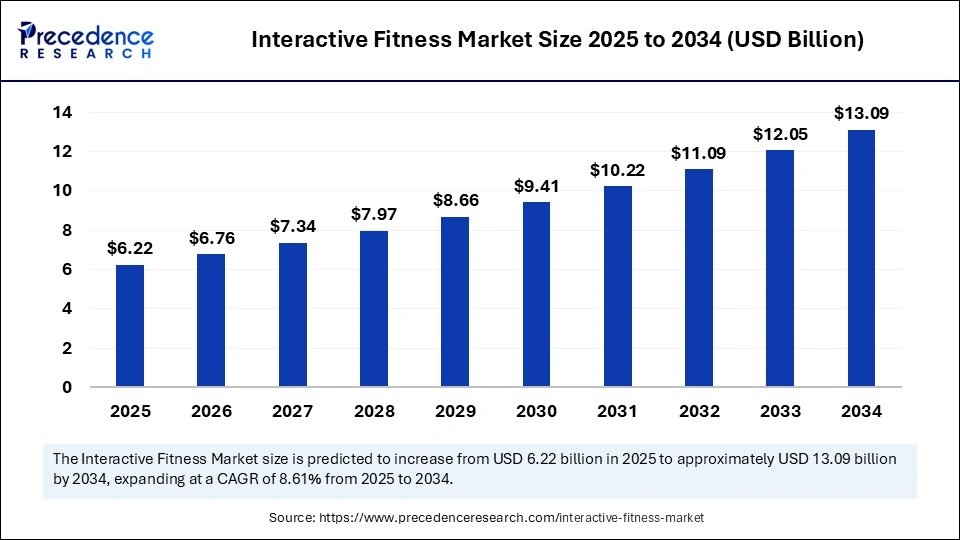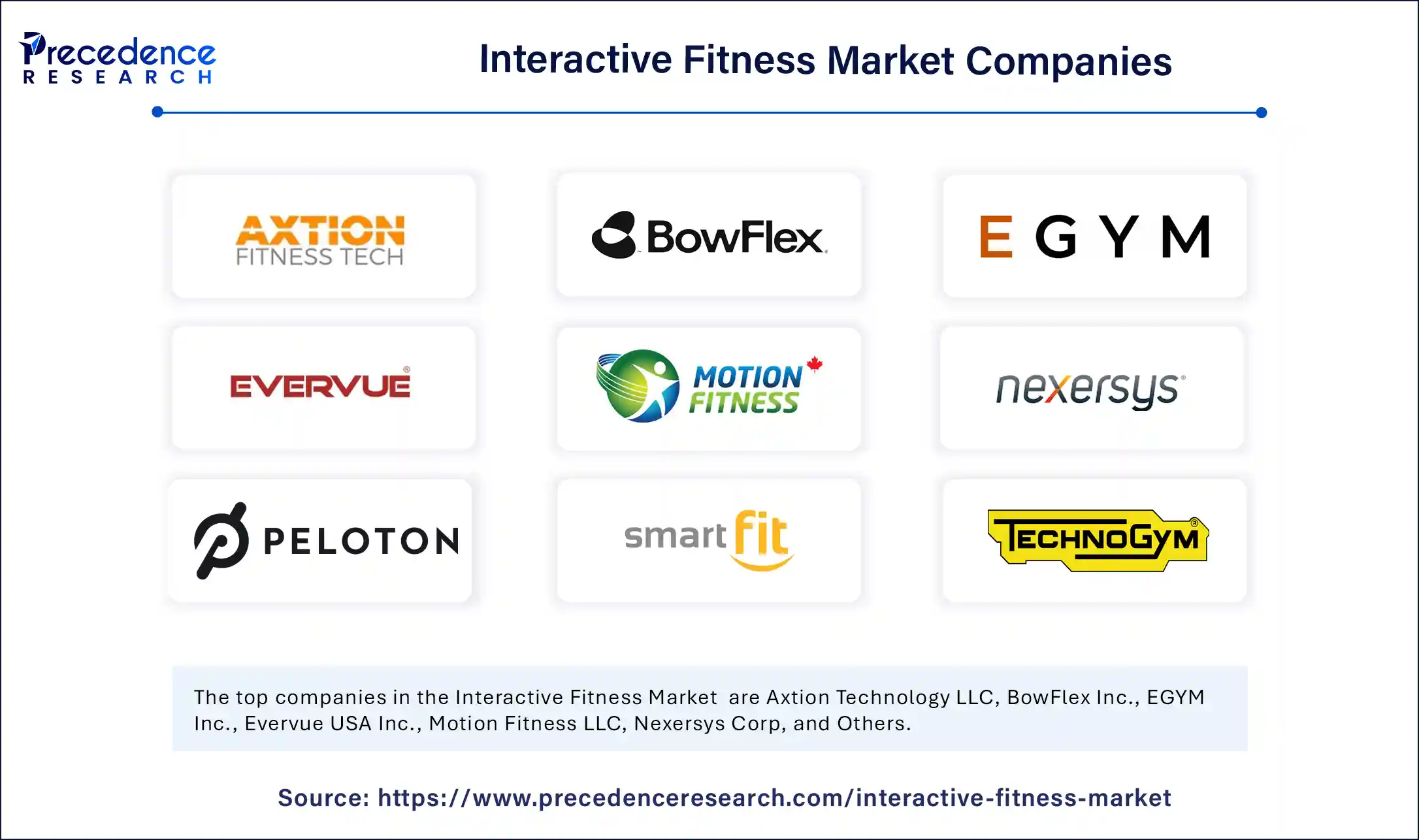
Interactive Fitness Market Key Points
- North America dominated the interactive fitness market with the largest revenue share in 2024.
- Asia Pacific is expected to grow at the fastest CAGR between 2025 and 2034.
- By product, the fitness equipment segment held the major revenue share of the market in 2024.
- By product, the software system segment is expected to grow at the highest CAGR during the forecast period.
- By application, the household segment contributed the biggest revenue share in 2024.
- By application, the gym segment is expected to expand at a significant CAGR in the coming years.
- By end-user, the residential segment dominated the market in 2024.
- By end-user, the non-residential segment is expected to register the fastest CAGR over the projection period.
Overview of Interactive Fitness
Interactive fitness refers to the integration of technology and digital content into physical workouts to create engaging, personalized, and immersive fitness experiences. It combines hardware (like smart exercise equipment), software (apps, platforms), and content (live or on-demand classes) to make exercise more interactive and motivating. Examples include Peloton bikes, Mirror, Tonal, Zwift, and fitness apps that offer real-time coaching, progress tracking, and gamification elements. These solutions are designed to keep users engaged and accountable, whether they’re working out at home, in the gym, or on the go.
How Is AI Transforming the Interactive Fitness Market?
AI is revolutionizing the interactive fitness sector by delivering hyper-personalized workout experiences tailored to each user’s unique data. By analyzing metrics such as fitness levels, goals, real-time performance, biometric signals, and feedback, AI-powered systems generate adaptive exercise plans that respond dynamically to a user’s progress. These virtual coaches—ranging from AI mirrors and mobile apps to smart gym equipment—offer instant guidance on form, intensity, and technique, ensuring exercises remain safe, effective, and engaging.
Additionally, AI is enriching interactive fitness through gamification, social features, and predictive analytics. Platforms and devices integrate real-time feedback, challenge-based rewards, and live leaderboards to keep users motivated and immersed. AI-driven predictive insights help prevent injuries by monitoring form and workload and recommending optimal recovery strategies. Equipped with cloud connectivity and computer vision, these solutions scale seamlessly—bringing immersive, data-driven fitness into homes, gyms, and corporate wellness programs around the world.
Interactive Fitness Market Growth Factors
-
Rise in Home Workout Demand
Increased interest in at-home fitness, especially since the COVID-19 pandemic, has led to greater adoption of interactive fitness platforms and connected equipment for convenient exercise routines. -
Advancements in AI & Real-Time Feedback
Integration of artificial intelligence allows for real-time feedback, form correction, and personalized workout plans, enhancing user engagement and workout effectiveness. -
Gamification & Engagement Features
Features like leaderboards, fitness challenges, and game-like experiences help motivate users by adding fun and competition to their workouts, increasing retention. -
Expansion of Connected Equipment & Apparel
The market is seeing a rise in smart bikes, interactive mirrors, wearables, and VR-based systems that combine hardware with cloud-based fitness content for immersive experiences. -
Growing Commercial & Corporate Adoption
Fitness studios, gyms, corporate wellness programs, and rehab centers are increasingly adopting interactive solutions to modernize offerings and boost engagement. -
E-Commerce & Omnichannel Expansion
The availability of interactive fitness products through both online and offline channels is making it easier for consumers to access and try new fitness technologies. -
Health Awareness & Wellness Culture
Growing awareness of physical health, lifestyle diseases, and mental well-being is driving consumers toward more engaging and data-driven fitness experiences.
Market Scope
| Report Coverage | Details |
| Market Size by 2034 | USD 13.09 Billion |
| Market Size in 2025 | USD 6.22 Billion |
| Market Size in 2024 | USD 5.73 Billion |
| Market Growth Rate from 2025 to 2034 | CAGR of 8.61% |
| Dominating Region | North America |
| Fastest Growing Region | Asia Pacific |
| Base Year | 2024 |
| Forecast Period | 2025 to 2034 |
| Segments Covered | Product, Application, End-User, and Region |
| Regions Covered | North America, Europe, Asia-Pacific, Latin America, and Middle East & Africa |
Market Dynamics
Market Drivers:
The interactive fitness market is witnessing substantial growth, primarily driven by the rising awareness of health and wellness, coupled with the increasing adoption of digital technologies in the fitness industry. Consumers are increasingly seeking engaging and personalized workout experiences, which has fueled the demand for smart fitness equipment and virtual training platforms.
The COVID-19 pandemic significantly accelerated the shift toward home-based fitness solutions, making interactive fitness platforms—such as Peloton, Tonal, and Mirror—an integral part of modern exercise routines. Technological advancements like AI-driven coaching, real-time performance tracking, and gamified workout experiences are enhancing user motivation and adherence.
Furthermore, the growing penetration of high-speed internet and smart devices has made interactive fitness more accessible to a broad user base, while the integration of fitness apps with wearables and health monitoring systems adds further convenience and value to the fitness journey.
Opportunities:
The market offers robust growth opportunities in areas such as personalized virtual training, AI-enabled workout optimization, and immersive technologies like augmented and virtual reality (AR/VR). As consumers demand more customized fitness programs, interactive platforms can leverage data analytics and machine learning to deliver dynamic workout plans tailored to individual fitness levels, goals, and health conditions. There is also significant potential for integration with healthcare and wellness ecosystems, enabling interactive fitness solutions to be used in preventive health management, rehabilitation, and corporate wellness programs.
Emerging markets present untapped potential as awareness of fitness rises and internet infrastructure improves. Additionally, the younger demographic’s preference for digital-first experiences, combined with the rising popularity of social fitness features—such as live leaderboards, group challenges, and community-based platforms—provides an opportunity for businesses to foster brand loyalty and drive subscription-based revenue models.
Challenges:
Despite its positive trajectory, the interactive fitness market faces several challenges. High initial costs of smart fitness equipment can act as a barrier, especially in price-sensitive markets. Not all consumers are technologically inclined, and some may find the learning curve associated with advanced features or interfaces discouraging.
Data privacy and security also pose significant concerns, as interactive platforms often collect personal health and behavioral data that must be safeguarded against breaches. Additionally, while the novelty of interactive fitness is a key attraction, sustaining long-term user engagement is difficult due to potential burnout, repetition, or lack of human connection compared to traditional gyms or personal training.
The market is also becoming increasingly saturated, with intense competition from both established fitness brands and new tech entrants. Maintaining innovation while managing costs and delivering a superior user experience will be critical for market players.
Regional Outlook:
North America remains the leading market for interactive fitness, driven by a high rate of digital adoption, a well-established fitness culture, and the presence of major players like Peloton and iFit. The United States, in particular, is a hub for innovation in connected fitness technologies and continues to lead in terms of user base and technological integration.
Europe follows closely, with countries like the UK, Germany, and the Nordic nations embracing interactive fitness solutions due to high health awareness and favorable economic conditions. The Asia-Pacific region is poised to witness the fastest growth, fueled by increasing urbanization, a growing middle class, and rising digital penetration in countries such as China, Japan, South Korea, and India. The market in these regions is also supported by younger demographics and a strong affinity for tech-enabled lifestyle solutions.
Latin America and the Middle East & Africa are in the nascent stages of adoption, but with rising fitness trends and expanding digital infrastructure, these regions hold promise for future market expansion. As the global fitness culture continues to evolve, interactive fitness is set to become a mainstream part of how consumers engage with health and exercise.
Interactive Fitness Market Companies

- Axtion Technology LLC
- BowFlex Inc.
- EGYM Inc.
- Evervue USA Inc.
- Motion Fitness LLC
- Nexersys Corp
- Paradigm Health and Wellness Inc.
- Peloton Interactive Inc.
- SMARTfit Inc.
- TECHNOGYM Spa
Segments Covered in the Report
By Product
- Fitness Equipment
- Software System
By Application
- Gym
- Household
By End-User
- Residential
- Non-residential
By Region
- North America
- Europe
- Asia Pacific
- Latin America
- Middle East and Africa
Also Read: Japan Video Streaming Market
Get this report to explore global market size, share, CAGR, and trends, featuring detailed segmental analysis and an insightful competitive landscape overview @ https://www.precedenceresearch.com/sample/6203
You can place an order or ask any questions, please feel free to contact at sales@precedenceresearch.com|+1 804 441 9344